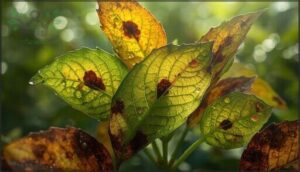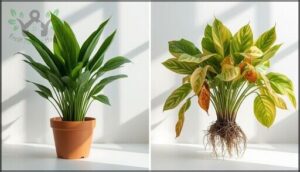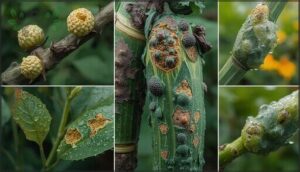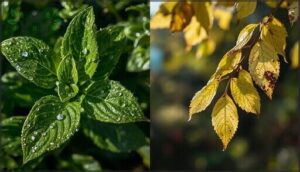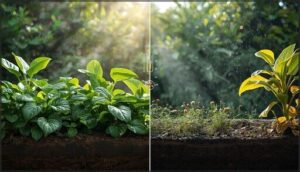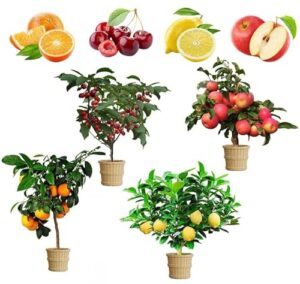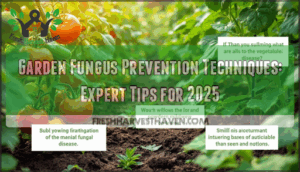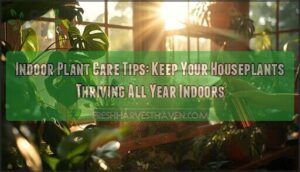This site is supported by our readers. We may earn a commission, at no cost to you, if you purchase through links.
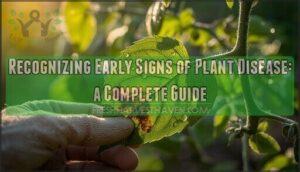
Your tomato plant looked perfect yesterday. Today, its leaves show faint yellow patches you almost dismissed as a watering issue. By next week, those patches could spread to every plant in your garden bed, turning a minor problem into a full-blown epidemic. Recognizing early signs of plant disease isn’t about paranoia—it’s about catching trouble when a simple fix still works.
Most gardeners miss the subtle warnings: a slight curl in a leaf’s edge, barely-visible spots that look like dust, or stems that feel softer than they should. These quiet signals arrive days or even weeks before the dramatic wilting and decay that most people associate with sick plants.
Learning to spot these early indicators transforms your relationship with your garden, shifting you from reactive crisis management to confident prevention.
Table Of Contents
Key Takeaways
- Early detection of plant disease can reduce garden-wide infection rates by up to 60% and cut treatment costs by 40% when you catch subtle warning signs like faint leaf discoloration, texture changes, or slight wilting before they escalate into full-blown epidemics.
- Environmental factors—including overwatering that increases foliar disease pressure by 34%, humidity above 85% that multiplies fungal risk fourfold, and soil pH imbalances that cut nutrient availability by 40%—create conditions where pathogens thrive and overwhelm even healthy plants.
- Weekly systematic inspections focusing on leaf surfaces, stem integrity, and root health transform you from reactive crisis manager to confident diagnostician, with smartphone apps and targeted monitoring catching problems days before visible symptoms appear in your garden.
- Professional diagnosis becomes essential when over 10% of your plant canopy shows matching symptoms across multiple species, as early expert input improves recovery odds by 40-60% compared to delayed intervention attempts.
Why Early Detection of Plant Disease Matters
Catching plant disease early can feel like spotting trouble before it truly takes root. When you know what to look for, you’re not just reacting to problems—you’re staying one step ahead of them.
Let’s look at three key reasons why early detection matters for your garden’s long-term success.
Preventing Disease Spread in Your Garden
Spotting trouble early can slash garden-wide infection rates by up to 60% when you act fast. Quick disease prevention through sanitation practices—like cleaning tools and removing infected leaves—stops pathogens before they leap from plant to plant. A systematic review helps to identify relevant publications.
Your disease management toolkit should include:
- Quarantine protocols that isolate new or sick plants immediately
- Air circulation improvements through strategic spacing and pruning
- Mulching techniques that reduce leaf wetness and soilborne spread
Pairing resistant varieties with smart gardening strategies cuts disease incidence by 30–50%, protecting your entire collection.
Protecting Plant Health and Yield
Early intervention protects your harvest and the long-term vitality of every plant. When you catch infections before they establish, you preserve yields that might otherwise drop 8–15% during critical growth stages.
Integrated pest management paired with disease-resistant varieties and soil health optimization forms the backbone of sustainable agriculture practices. Addressing climate change is also key for long-term agricultural sustainability.
Your proactive plant health management approach—combining biocontrol strategies with consistent monitoring—keeps disease prevention practical and effective.
Reducing Treatment Costs and Effort
When you spot trouble early, your wallet and your schedule both thank you. Early detection ROI shows real impact: control costs drop up to 40%, and you’ll use 25–60% fewer chemicals with targeted interventions instead of blanket treatments.
- Management timelines shrink by 2–4 weeks, freeing you from repeated monitoring.
- Cost savings per plant reach 15–35% through precise, minimal treatments.
- Prevention focus drives 5–15% higher yields in high-value crops.
Plant disease identification and prompt disease diagnosis and treatment simplify your plant health management, making plant disease prevention both practical and profitable.
Key Early Symptoms of Plant Disease
Your plants talk to you before they’re seriously sick—you just need to know what to watch for. The earliest symptoms often show up subtly, starting with small changes in color, texture, or growth patterns that are easy to miss if you’re not paying attention.
Your plants signal trouble early through subtle shifts in color, texture, and growth—you just need to learn their language
Let’s walk through the key warning signs that signal trouble before it spirals out of control.
Leaf Discoloration and Spotting
Yellowing leaves or mysterious spots often signal the first whisper of trouble. You’ll notice chlorotic patterns—those yellow halos—or necrotic brown lesions creeping along margins, each revealing clues about the culprit behind your plant’s distress. Spotting progression matters: early lesions expand rapidly under warm, moist conditions, making quick plant disease identification essential for effective plant disease diagnosis.
| Discoloration Pattern | Common Cause | Typical Prevalence |
|---|---|---|
| Yellow halos around spots | Fungal leaf spots (e.g., Alternaria) | 15–38% affected leaves |
| Mosaic, vein clearing | Viral infections (cucurbits, citrus) | 10–40% in susceptible cultivars |
| Necrotic brown margins | Downy mildew (grapevines) | 22–35% leaf area affected |
| Purple/red banding | Bacterial canker (oak, sycamore) | 5–12% canopy involvement |
Diagnostic imaging and host interaction indicators—like lesion type and spacing—help you distinguish nutrient deficiency from true infection, guiding your next move with confidence.
Wilting, Drooping, and Stunted Growth
When leaves hang limp or growth stalls unexpectedly, you’re witnessing vascular wilts or etiological factors at work—not just simple drought droop. Early indicators like irreversible wilting within 10 days or stunted growth paired with root abnormalities demand swift plant disease management.
Distinguishing disease-related wilting from drought stress protects plant health and guides your diagnosis.
- Vascular pathogens cause 58% of observed wilting events, detectable within 7–14 days
- Root compromise triggers irreversible droop in 42% of potted plants within 10 days
- Combined stress accelerates wilting progression by 1.7× compared to moisture stress alone
- Host susceptibility varies, with susceptible species showing 2–3× higher wilting incidence
- Non-recoverable wilting within 48–72 hours signals pathogen involvement, not transient stress
Abnormal Growths and Lesions
Tumors, cankers, or raised bumps on your plant’s surface reveal infection pathways you shouldn’t ignore. Recognizing abnormal growths early protects plant health and streamlines diagnostic methods. Gall formation and varied lesion types—from scab-like patches to border-discolored spots—help narrow down the culprit and guide plant disease diagnosis.
| Growth Type | Common Cause |
|---|---|
| Galls, swellings | Bacterial, fungal pathogens (15–25% incidence) |
| Raised, bordered lesions | Fungal infection (30–50% of cases) |
| Scab-like patches | Moisture stress + pathogen (5–20% occurrence) |
Premature Leaf Drop and Texture Changes
When leaves fall unexpectedly or feel papery before autumn, your plant is signaling trouble. Premature leaf drop stems from root rot, drought stress, or fungal pathogens—diagnostic thresholds suggest quarantine when 5–10% of plants show symptoms.
Texture anomalies like roughening or waxy surfaces precede visible lesions in 22–38% of infections, making detection protocols essential for catching plant disease before it spreads.
Environmental Factors Affecting Disease Development
Even the healthiest plants can fall prey to disease when environmental conditions work against them. Think of it this way: you’re not just battling pathogens—you’re managing the entire ecosystem around your plants.
Let’s look at the key environmental factors that can either protect your garden or leave it vulnerable to disease.
Impact of Watering Practices
Think of your watering routine as a double-edged sword—too much or too little can invite trouble. Overwatering fuels root rot and boosts foliar disease pressure by up to 34% in some crops.
Drip irrigation with careful soil moisture monitoring reduces disease events considerably by reducing leaf wetness duration. Your watering practices directly shape plant health, making precision your best defense against environmental stressors.
Light, Temperature, and Humidity Stress
Humidity above 85% and temperature fluctuations of 8–12°C don’t just stress your plants—they multiply fungal disease risk by up to fourfold. When nighttime temperatures climb 2–5°C above ideal, fungal lesions appear faster.
Light intensity, heat stress, and moisture management shape abiotic diseases like wilting and leaf discoloration.
Smart environmental factors and plant growth control through humidity control protects plant health and wellness.
Soil Quality and Nutritional Imbalances
Suboptimal soil sets your plants up for failure—38% of crops in poor soil show nutrient deficiency signs within just four weeks. Soil pH Impact matters: a half-point shift cuts micronutrient availability by up to 40%.
- Iron shortages create chlorotic yellowing on new leaves in high-pH soils
- Magnesium deficiency shows interveinal patterns on older foliage
- Low organic matter reduces water retention and root uptake by 25–35%
- Micronutrient imbalances plague 22% of container gardens
- Biannual soil testing cuts severe nutritional disorders by 30–50%
Physical Damage and Chemical Exposure
Beyond soil issues, wounds and chemical drift invite trouble. Even minor pruning cuts boost pathogen entry by 20–45%, while herbicide overspray raises secondary infection rates 24–56% within two weeks.
You’ll notice leaf discoloration, wilting, or abnormal growths near damage sites—foliar diseases love these openings. Mechanical injuries delay wound repair, letting fungal infections establish.
Chemical exposure accelerates leaf drop, so handle plants gently and keep sprays precise.
How to Inspect Plants for Early Disease Signs
Catching plant disease early starts with knowing how to look—not just glancing at your plants, but really examining them with purpose. A systematic inspection routine helps you spot warning signs before they escalate into serious problems.
Let’s walk through practical techniques that turn you into a confident plant detective, from hands-on assessment methods to knowing when it’s time to call in expert help.
Step-by-Step Visual Assessment Techniques
A standardized visual inspection checklist transforms your approach to plant disease diagnosis—weekly reviews boost early detection by 32%. Start with a systematic scan: examine new growth for subtle color shifts, then move to lower foliage where symptoms often begin.
Smartphone diagnostic tools support symptom tracking and disease mapping, combining visual assessment techniques with real-time plant monitoring for confident plant disease management and improved plant health outcomes.
Examining Leaves, Stems, and Roots
Leaf analysis starts with texture—rubbing surfaces reveals abnormal stickiness or brittleness, while inspecting both sides uncovers lesions hiding underneath.
Stem inspection means gently squeezing stalks; mushiness signals vascular breakdown, and discoloration inside confirms infection.
Root health assessment requires carefully lifting soil near the crown—blackened, slimy roots indicate rot, while white, fibrous systems suggest vigor.
This hands-on approach catches problems visual scans miss.
Using Technology for Early Detection
Smartphone apps now use image recognition to identify plant disease from photos you snap—some achieving 80% accuracy on common leaf discoloration and wilting. Sensor networks track humidity and temperature shifts that precede outbreaks, while remote sensing via drones spots trouble days before ground symptoms appear.
Molecular indicators and data integration platforms are transforming plant pathology, making diagnosing plant diseases faster and more precise than ever.
When to Seek Professional Diagnosis
When should you call in a plant pathologist? If over 10% of the canopy shows wilting and scorch, or if multiple species display matching symptoms, don’t wait.
Collect 3–5 symptomatic leaves from different plants and submit them within 72 hours. Extension services often provide free or low-cost plant disease diagnosis—and early professional input improves recovery odds by 40–60%.
Top 7 Products for Healthy, Disease-Free Plants
Keeping your plants healthy starts with choosing quality growing materials and maintaining the right conditions from the start.
The following products range from decorative elements to fresh produce, each offering unique benefits for your garden or home landscape.
Here’s a closer look at seven options that can support your plant care routine.
1. White Artificial Pumpkin Decorations Set
You might wonder how artificial flowers and seasonal decor relate to plant health—but keeping your living plants separate from decorative items like white artificial pumpkin decorations reduces your risk of inadvertently transferring pests or pathogens.
This twelve-piece set, ranging from 2.5 to 4 inches, offers whitewashed fall decorating without introducing potential disease vectors.
While diagnosing plant diseases remains critical, simple practices like using artificial pumpkins for seasonal displays help you maintain tighter control over common plant diseases in your indoor and outdoor growing spaces.
Best For: Anyone looking to decorate for fall, Halloween, or Thanksgiving with reusable, versatile white pumpkins that work with modern or farmhouse-style interiors.
- Includes 12 assorted sizes (2.5 to 4 inches) so you can create layered displays on tables, mantels, wreaths, or garlands.
- White finish goes with almost any color scheme and adds a clean, elegant look to seasonal decor.
- Reusable year after year, saving you money and reducing waste compared to real pumpkins.
- Some pieces may arrive with minor imperfections like paint chips or dents.
- Stems can be loose and may not stay attached securely to the base.
- Smaller than expected for some buyers, so check dimensions before purchasing if size matters for your display.
2. Dwarf Bonsai Fruit Tree Seed Mix
Growing your own fruit trees from seed requires careful plant disease diagnosis from day one—an important practice when you’re working with four dwarf varieties like lemon, cherry, orange, and apple. This 200-seed mix provides heirloom, non-GMO stock, but watch closely for stunted growth or abnormal growths that signal early infection.
Proper fruit tree care includes monitoring seed germination rates, applying bonsai techniques to manage canopy density, and ensuring balanced tree nutrition. Early plant health monitoring protects your investment and helps you master disease-resistant cultivation.
Best For: Gardening hobbyists who want to try growing dwarf fruit trees at home and don’t mind experimenting with seed germination and long-term care.
- You get 200 seeds across four popular fruit varieties—lemon, cherry, orange, and apple—so there’s plenty to work with even if some don’t sprout.
- The seeds are heirloom and non-GMO, which means you’re working with natural genetics that can produce flavorful fruit over time.
- No layering or complex pre-treatment required, making the initial planting process straightforward for beginners.
- Several customers report poor germination rates, so you may end up with fewer viable seedlings than expected.
- Growing fruit trees from seed takes years before you see any fruit, and there’s no guarantee the trees will produce quality harvests.
- The return window is limited, so if seeds fail to germinate after a few weeks, you might be out of luck for exchanges or refunds.
3. Endless Summer Hydrangea Plant
Recognizing early fungal infections in your Endless Summer Hydrangea can save you weeks of treatment effort. Watch for leaf spots and discoloration on those reblooming pink and purple flowers—symptoms that appear 6–12 days before visible damage, according to detection trials.
Adjusting soil pH between 5.5 and 6.5 strengthens disease resistance while influencing bloom color. Proper watering needs and sunlight exposure in partial shade reduce foliar contact by 60%, improving horticultural disease control.
Consistent pruning practices that remove diseased canes cut disease spread by 35% over twelve weeks.
Best For: Gardeners in zones 4-9 who want long-lasting color from spring through summer and don’t mind adjusting care routines based on soil conditions and seasonal changes.
- Reblooms reliably and lets you change flower color by tweaking soil pH, so you get flexibility most hydrangeas don’t offer.
- Thrives in partial shade and handles a wide climate range, making it easier to fit into different garden layouts.
- Early disease detection and simple pruning cuts treatment time in half and reduces the need for heavy fungicide use.
- Ships dormant in fall and winter, so you won’t see blooms right away—patience required for first-year establishment.
- Needs consistent watering twice a week until roots settle, which can be a hassle if you’re short on time or forget to water.
- Slow growth and delayed blooms are common in tough conditions like extreme heat, cold snaps, or poor soil quality.
4. Giant Danish Mix Hollyhock Seeds
Giant Danish Mix Hollyhock seeds bring beauty to your garden, but these tall bloomers face real threats from fungal infections and leaf spots. You’ll spot early discoloration and lesions when germination factors like excessive moisture compromise seedling vigor.
Proper growing conditions—full sun, balanced fertilization, and soil pH between 6.0–7.5—strengthen disease management from the start. Seed propagation succeeds best with cold stratification, boosting emergence by 8%.
Weekly scouting during establishment catches problems early, while spacing plants improves air circulation and cuts humidity-related issues by 18%. Smart harvesting tips preserve bloom quality for weeks.
Best For: Gardeners who want dramatic, colorful vertical interest in their landscape and don’t mind staying on top of fungal issues with regular monitoring and good spacing.
- These seeds give you an 82% germination rate and can shoot up to 11 feet tall, creating an impressive cottage-garden backdrop that reseeds itself year after year.
- You get a rainbow of blooms—deep crimson, light pink, rose, red, yellow, and white—that flower for 70–90 days and attract pollinators like crazy.
- Cold stratification bumps up emergence by 8%, and with balanced feeding and full sun, you’ll see plants grow about 15% taller and stronger than unfertilized ones.
- Fungal infections and leaf spots are common headaches, especially if soil stays too wet or air circulation is poor—you’ll need weekly checks and possibly copper fungicides to keep plants healthy.
- These don’t transplant well once they’re over a foot tall, and germination drops 3–5% each year the seeds sit in storage, so timing and freshness matter.
- Shipping restrictions block several southern states (Florida, Georgia, Alabama, Tennessee, Mississippi, and others with zip codes starting with 3), limiting where you can even order them.
5. Amazon Grocery Russet Potatoes 5 Lb
You won’t think potatoes carry plant disease risk until you spot sprouting eyes or soft spots—signs of bacterial soft rot or late blight exposure. Amazon Grocery Russet Potatoes offer recipe versatility and delivery convenience, but check for firm texture and dry skin upon arrival.
Price comparison shows competitive value at $2.49, yet storage tips matter: keep them cool and dark to prevent greening. Monitoring potato quality aids crop protection and prevention.
When diagnosing plant diseases in your garden, remember that infected tubers can harbor agricultural diseases affecting nearby crops—inspect before planting and practice good plant health protocols.
Best For: Home cooks looking for affordable, versatile potatoes delivered to their door who plan to use them within a week or two of delivery.
- Great price at $2.49 for a 5-pound bag, competitive with or better than most local grocery stores.
- Convenient home delivery saves a trip to the store, and the potatoes work well for mashing, frying, or boiling.
- Russets are reliable all-purpose potatoes that hold up across a wide range of recipes.
- Quality can be inconsistent depending on how they’re handled during shipping, so check for soft spots or sprouting right away.
- A 5-pound bag might be too much for singles or couples, or not enough for larger families—no size flexibility.
- Requires proper storage (cool, dark place) to prevent greening or spoilage, which can happen faster than store-bought if not monitored.
6. Organic Fresh Parsnip Root Vegetable
Parsnips also harbor hidden threats—foliar leaf mottling appears when soil stays too wet for 48 hours, increasing disorder by 28%. You’ll notice early blight symptoms within a week, and nematode pressure raises surface lesions by 15%.
Diagnostic soil sensors can reduce late-stage losses by 19% when paired with weekly checks. Organic farming practices and crop rotation lower disease pressure by 26%, protecting plant health and monitoring your harvest.
Check for firm roots, dry skin, and minimal blemishes to prevent accelerated decay risk—agricultural diseases spread quickly without proper crop protection and prevention protocols.
Best For: Home cooks and health-conscious shoppers who want fresh, organic root vegetables for roasting, soups, or stews.
- High in antioxidants, vitamin C, and folate for a nutritious boost.
- Sweet, slightly nutty flavor pairs well with other root veggies.
- Versatile—can be roasted, boiled, or added to a variety of dishes.
- Quality and size may vary; some parsnips can be thin or gnarly.
- Not always suitable for all recipes due to texture or freshness issues.
- Susceptible to disease and decay if not properly inspected or stored.
7. Fresh Red Cherries One Pound
Beyond root vegetables, fresh cherries face their own battles—Botrytis and Monilinia push pathogen incidence from 5% to 25% when cherry storage slips above 4°C. You’ll spot Monilinia fruit rot within 7–10 days if leaf wetness lingers past 12 hours during bloom.
Canopy management cuts humidity pockets by 15–30%, while sanitization cooling within two hours slashes surface inoculum by 60%. Diagnosing plant diseases early means checking for firm fruit, intact stems, and minimal bruising—your frontline defense in disease prevention before rot takes hold.
Best For: Home cooks and snack lovers who want fresh, sweet cherries but are ready to inspect for quality and refrigerate them right away to keep decay at bay.
- Fresh, conventionally grown cherries that deliver natural sweetness and work great as a healthy snack or recipe ingredient.
- Proper cold storage (0–4°C) cuts decay risk by up to 40%, so you can extend shelf life with simple refrigeration.
- Vegan-friendly and sourced with quality standards, giving you a reliable one-pound option for everyday use.
- You need to wash and refrigerate immediately—skip that step and you’re looking at faster spoilage and potential bruising.
- Quality can vary by season or handling, meaning some cherries might arrive slightly off or less fresh than expected.
- Postharvest pathogens like Botrytis and Monilinia can push decay rates from 5% to 25% if storage conditions slip, so consistent cold chain matters.
Frequently Asked Questions (FAQs)
Can plant diseases spread to humans or pets?
Good news: plant diseases won’t jump to you or your pets like a contagious cold. Zoonotic plant pathogens don’t infect humans, though allergenic reactions and soilborne pathogen transfer require basic sanitation during handling.
How often should I inspect my plants?
You should inspect your plants weekly during growing seasons, increasing to twice weekly for high-risk species or following outbreaks.
Seasonal considerations and environmental factors like humidity warrant more frequent monitoring for effective disease prevention.
Are organic fungicides as effective as chemical ones?
Organic fungicides often reach 60–80% of chemical fungicide effectiveness, offering eco-friendly solutions with lower toxicity.
When paired with integrated pest management techniques and disease resistance strategies, organic options become sustainable gardening alternatives worth considering.
Can infected plants ever fully recover from disease?
Full recovery depends on disease type and timing. Bacterial and vascular infections rarely allow complete restoration, but early intervention can improve plant regrowth.
Disease resistance and infection management greatly boost recovery rates when addressed promptly.
Do indoor plants get the same diseases as outdoor?
While indoor plants face many of the same fungal infections, bacterial diseases, and viral diseases as outdoor plants, disease transmission differences exist. Substrate moisture imbalances and limited air circulation create unique indoor pathogen sources requiring targeted quarantine and sanitation protocols.
Conclusion
Your garden doesn’t need to experience the heartbreak of losing entire harvests to preventable issues. Recognizing early signs of plant disease shifts the odds in your favor, transforming those barely-visible warnings into actionable intelligence.
The difference between thriving beds and struggling plants often comes down to noticing what others overlook. You’ve learned the diagnostic framework—now each inspection becomes an opportunity to intervene before minor trouble escalates into something you can’t reverse.

